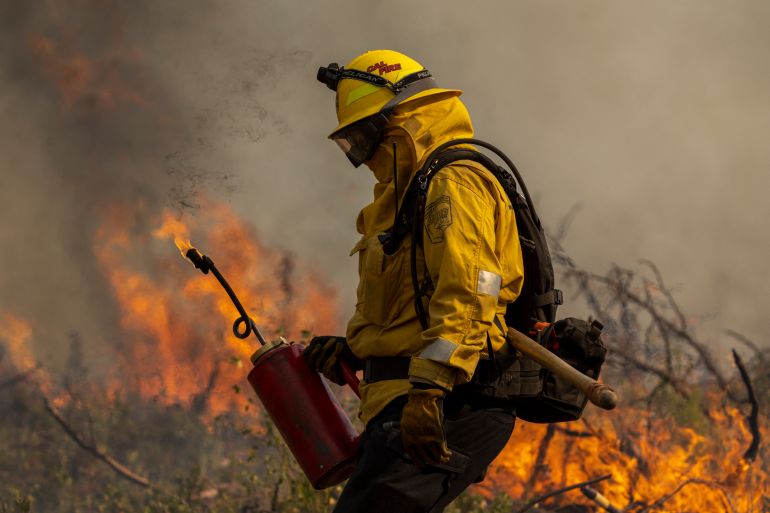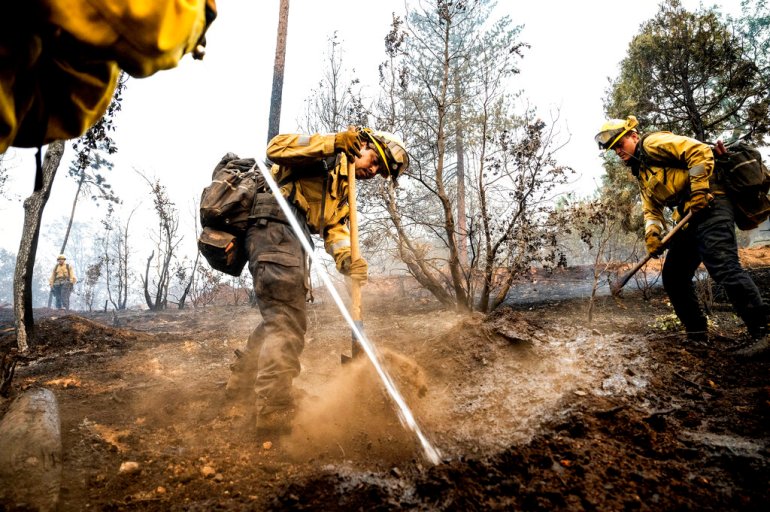US federal firefighters grapple with staffing crisis
The low-paid workforce is stretched dangerously thin, firefighters say, as record-setting blazes rage across the country.

Los Angeles, California, US – Facing longer and more intense wildfire seasons, US federal firefighters say their workforce is beset by low wages and mounting vacancies, which are affecting their ability to do their job.
As prolonged periods of drought and rising temperatures turn overgrown forests into kindling, tens of thousands of fires have ripped through millions of acres of land across the United States this year.
Keep reading
list of 3 itemsHow climate change drives heatwaves and wildfires
Why are wildfires raging in Europe?
But despite a growing need for firefighters’ services, the staffing crisis continues to worsen, worker advocacy groups and firefighters say.
“The worse fires get and the more short-staffed crews become, the more trauma gets loaded onto firefighters,” Kelly Ramsey, a former firefighter with the US Forest Service (USFS), told Al Jazeera. “The work is inherently dangerous, but it’s less safe if crews don’t have the resources they need.”
Nearly a dozen federal firefighters, who spoke with Al Jazeera on condition of anonymity for fear of retaliation, said vacancies in California and other western states remain “widespread and extensive”.
“We didn’t have enough people to fill all our positions, so we asked around to see if other crews had extra workers who could help out,” one California-based firefighter said. “But everyone else was having the same problem we were. They were all low on staff.”
For gruelling work that includes ferrying crews in and out of fire zones via helicopter, using heavy equipment to contain fires, and parachuting into fire zones, the minimum wage for federal wildland firefighters stands at just $15 an hour. Some workers say they have turned to crowd-funding websites to cover medical expenses, while others cannot afford basic necessities, such as housing.
Tim Hart, a smokejumper who died last year after parachuting in to fight a fire in New Mexico, had reportedly lived out of his truck for several fire seasons. A bill before Congress named in Hart’s honour would bolster pay and benefits for those in the profession.
“Throughout his career as a wildland firefighter, Tim battled low pay, endured multiple injuries, and spent months at a time away from his family,” his wife, Michelle Hart, told Al Jazeera. “There needs to be appropriate pay and assistance for those who risk their lives to fight more intense, prolonged fire years.”
‘Frighteningly common’
Meanwhile, wildfire seasons continue to break records.
In California, eight of the 10 largest wildfires in the state’s history have occurred since 2017 (PDF), as blazes displace residents and spread acrid smoke from the iconic vineyards north of San Francisco to beachside communities in Malibu.
In the western US, federal agencies say that recruiting and retaining workers has been especially difficult. USFS spokesperson Michelle Burnett told Al Jazeera that pay is “not as competitive as we would like it to be”, adding that the administration of US President Joe Biden “is committed to working with Congress to secure much-needed investments and to grow this critical workforce”. Federal agencies also have to compete for workers with state-level agencies that often offer better pay.
Biden recently announced a temporary wage increase for federal firefighters of up to $20,000 a year, but acknowledged “there is more work to do, especially as climate change fuels more wildfires”. California Senator Dianne Feinstein this month highlighted the massive staffing gap, citing around 1,650 vacancies in the federal firefighting workforce, including 650 in California alone.
Short staffing can be dangerous in this profession. During a wildfire in California last year, Ramsey said there were not enough crews available to carry out vital tasks, such as clearing out unstable trees that could easily collapse if they caught fire. A tree then collapsed on one of her colleagues, who escaped with minor injuries.
“It was a classic example of what happens when an incident is short-staffed,” Ramsey said, adding that staffing problems are “frighteningly common”.
While several workers told Al Jazeera that the temporary pay raise has boosted morale, advocacy groups say it must be followed up by more comprehensive, long-term steps to turn working as a firefighter for the federal government into a sustainable career choice.

“Folks only get this raise for one more year, and if it isn’t followed up by meaningful reform, a lot of people might treat it like a severance package,” Jonathon Golden, a policy analyst with Grassroots Wildland Firefighters, told Al Jazeera. “There’s only so much blood you can squeeze from one stone.”
Indeed, there are concerns that when the raise ends next year, firefighters could lose hope.
“We see the president putting out statements celebrating this,” said a firefighter with the Bureau of Land Management. “But a lot of people are worried that over time, the concern will fade, and … we’ll be right back where we were before.”